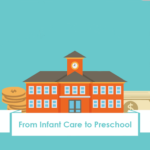
Your baby is now more mobile than ever and is constantly on the move. He or she finds pleasure in dropping a spoon from the high chair – and do it over and over again. On most days, you find that “No!” seems to be your word of the day.
Now, this is what life will look like with a 10- to 12-month-old at home!
Here are some things that you can expect your baby to do from 10 to 12 months.
Better hand-eye coordination
At this age, most babies can feed themselves finger foods such as baby rice biscuits and steam vegetable sticks, as they grasp items between the thumb and forefinger. Your baby also loves banging blocks together, placing objects in a container and shaking the container or taking the items out. He or she also loves poking things (and your face!) with his or her index finger.
Advanced motor skills
By now, most babies can sit independently and pull themselves to a standing position. They will start with crawling and cruising along the furniture and this eventually leads to walking. Some 12-month-olds may take their first steps without support.
New cognitive skills
Your baby’s understanding of object permanence develops, as he or she is able to find hidden objects with ease. Although your baby still cries when you leave him or her, he or she will soon realise that you still exist and that you’re just out of sight for a while.
A rather cute development is taking place at this stage too: your baby will start to imitate you at everyday tasks such as combing his or her hair and talking on the phone.
Improved communication
By 12 months old, most babies can respond to simple verbal requests. You would have noticed that your baby is now skilled at various gestures while communicating such as shaking his or her head to indicate ‘no’ or waving goodbye.
Your baby’s babbling will get more advanced at this stage and you can hear more clearly, the words “mama” and “dada”. You might even hear expressive words such as “uh-oh!”.
What you can do to help your baby’s development from 4 to 6 months
Your baby is extremely curious now and is bound to keep you on your toes. Here’s what you can do to encourage him or her to learn while keeping things safe:
Read a good book
At this age, your baby gets fascinated by books with flaps, textures and activities. So do set aside time for reading every day and keep the experience interesting through facial expressions, sound effects and voices for characters.
Keeping the books within a level that is easily reached by your baby is a great idea as this encourages him or her to explore and develop a look for books and reading.
Initiate small talk
Keep talking to your baby as he or she busies himself or herself with actions. For example, if your baby reachers for a book, you can ask, “Would you like me to read this book to you?”. If he or she points to the frog on the cover, say something like, “You found Mr Frog! What do you think the frog is saying?”. Wait for your baby’s response and encourage him or her with the correct answer.
Besides just reading the words on the pages, you can make up your own stories to fit the pictures as you go along. Here’s your chance to ask your baby lots of questions and keep him or her talking.
Help your baby to make sense of his or her feelings
At this stage, your baby is struggling to make sense of the world around him or her, so expect tantrums and episodes of frustration. Explain to your baby how things work when he or she throws things out of frustration. For some babies, communicating via sign language can help them express their needs more effectively. You can teach them simple, everyday words such as milk and sleep.
Keep frustrating moments under control
Babies don’t have a sense of right and wrong yet, but you can help him or her differentiate these by praising your baby for good choices and moving him or her award from dangerous situations.
Set some boundaries as to what constitutes acceptable behaviour. Calmly tell him or her “no” when your baby hurts others – then calmly explain why his or her behaviour is not acceptable and redirect his or her attention elsewhere.
Keep the environment safe for exploring
Keep your home baby-safe by having only safe objects within your baby’s reach. Stow away items that could be poisonous, pose a choking hazard or break into small pieces and cause a cut.
Here are some tips to help you get started:
- Cover electrical outlets
- Use safety gates to barricades no-go zones such as the kitchen and staircase
- Place cords from blinds and shades out of reach
- Install child locks on doors and cabinets
- Remove furniture with sharp edges from your baby’s play area – the same also goes for lightweight objects that your baby is bound to use to pull up to a standing position
- Mount book shelves, drawers and television to the wall
When should you be worried?
It is normal for your baby to reach some developmental milestones on schedule or ahead of time, but lag behind on others.
However, it is good to be aware of the warning signs of developmental delay and see your baby’s doctor if you notice any of these symptoms by his or her first birthday:
- Doesn’t babble or try to say words such as “mama” or “dada”
- Doesn’t use gestures such as waving or shaking his or her head
- Doesn’t point to objects or pictures
- Doesn’t show interest in searching for objects that are hidden
- Doesn’t crawl properly or consistently drags one side of the body while crawling
- Can’t stand independently























